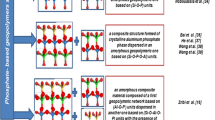Abstract
The characteristic property of naturally-occurring geopolymers is a high content of humic materials that are recognized by the nitrogen function. Through a simulated geopolymerization, biopolymers with non-nitrogen function, such as xanthan gum, were found to have the characteristics of humic acid by means of UV–Vis spectrometry. This fact ascertains that any kind of biopolymer may naturally transform to a geopolymer. A geopolymer is a type of crosslinked long-chain compound, built in three-dimensional structures whose property is immune to microbial degradation. A crosslinked biopolymer was shown to have the same characterization as a geopolymer that has a long life due to its crosslinking capacity and anti-microbial properties. In this study, the formation of petroleum-based geopolymers (e.g., kerogen) was introduced. This study may elucidate the structure of geomacromolecules and the mechanism of their formation, closely related with crosslink reaction between inorganic and organic molecules. This will further change the conventional definition of geopolymer that involves only the inorganic geopolymer.




Similar content being viewed by others
References
Andelkovic T, Andelkovic D, Perovic J, Purenovic M, Polic P (2001) Decrease of oxygen interference on humic acid structure alteration during isolation. Facta Univ Ser Phys Chem Technol 2(3):163–171
Andrady A (1994) Assessment of environmental biodegradation of synthetic polymers. Rev Macromol Chem Phys C34(1):25–76
Atlas RM, Bartha R (1998) Microbial ecology, 4th edn. Benjamin/Cummings, California
Barancikova G, Senesi N, Brunetti G (1997) Chemical and spectroscopic characterization of humic acids isolated from different Slovak soil types. Geoderma 78:251–266
Bartha R, Pramer D (1965) Features of a flask and method for measuring the persistence of pesticides in soil. Soil Sci 100:68–70
Davidovits J (1993) From ancient concrete to geopolymers. Arts Metiers Mag 180:8–16
Duarte RMBO, Santos EBH, Duarte AC (2003) Spectroscopic characteristics of ultrafiltration fractions of fulvic and humic acids isolated from an encalyptus bleached Kraft pulp mill effluent. Water Res 37:4037–4080
Garcia OF, Santos VE, Casas JA, Gomez E (2000) Xanthan gum: production, recovery, and properties. Biotechnol Adv 18:549–579
Henrichs SM (1992) Early diagenesis of organic matter in marine sediments: progress and perplexity. Mar Chem 39:119–149
Kelco Technical (1999) Kelco technical brochure. DB 15, San Diego
Kesavan S, Prud’homme RK (1992) Rheology of guar and HPG cross-linked by borate. Macromolecules 25:2026–2032
Kim D, Yen TF (2006) Denitrogenation. In: Lee S (ed) Encyclopedia of chemical processing. Marcel Dekker, New York (in press)
Kim D, Petrisor IG, Yen TF (2003) Disposal of hazardous waste from cathode ray tubes. American Institute of Chemical Engineers (AIChE) annual meeting, San Francisco, pp 16–21
Kim D, Petrisor IG, Yen TF (2004) Geopolymerization of biopolymers: a preliminary inquiry. Carbohyd Polym 56:213–217. DOI 10.1016/j.carbpol.2004.02.006
Kim D, Petrisor IG, Yen TF (2005) Evaluation of biopolymer-modified concrete systems for disposal of cathode ray tube glass. J Air Waste Manage Assoc 55:961–969
Larsen G, Chilingar GV (1967) Diagenesis in sediments. Developments in sedimentology 8. Elsevier, New York, p 551
Mimura HH, Ohta H, Akiba K, Onodera Y (2002) Uptake and recovery of ruthenium by alginate gel polymers. J Nucl Sci Technol 39(6):655–660
Momeni D (2001) Experimental studies of biopolymers behavior in subsurface porous strata. PhD Dissertation, University of Southern California
Park TG, Choi HK (1998) Thermally induced core-shell type hydrogel beads having interpenetrating polymer network (IPN) structure. Macromol Rapid Commun 19:167–172
Plank J (2004) Applications of biopolymers in construction engineering. Appl Microbiol Biotechnol 66:1–9
Tuncel A, Unsal E, Cicek H (2000) pH-Sensitive uniform gel beads for DNA adsorption. J Appl Polym Sci 77:3154–3161
Walton AG, Blackwell J (1973) Biopolymers. Academic, New York
Yabannavar AV, Bartha R (1994) Methods for assessment of biodegradability of plastic films in soil. Appl Environ Microbiol 60:3608–3614
Yen TF (1972) Terrestrial and extraterrestrial stable organic molecules. In: Landel R (eds) Chemistry in space research. American Elsevier Publishing Company, New York
Yen TF (1976) Structural aspect of organic compounds in oil shales. In: Yen TF, Chilingar GV (eds) Oil shale. Elsevier, Amsterdam, pp 127–148
Young DK, Yen TF (1977) The nature of straight-chain aliphatic structure in Green River kerogen. Geochim Cosmochim Acta 41:1411–1417
Young DK, Sprang SR, Yen TF (1974) Studies of the precursors of naturally-occurring organic components in sediment. In: Symposium on chemistry of marine sediments, Atlantic City, pp 8–13
Acknowledgements
This work was financially supported by the US Department of Energy (DOE), under the contract, DE-AC 2601 NT 41307. Authors would like to acknowledge Ms. Rachel Tucker for technical assistance.
Author information
Authors and Affiliations
Corresponding author
Rights and permissions
About this article
Cite this article
Kim, D., Lai, HT., Chilingar, G.V. et al. Geopolymer formation and its unique properties. Environ Geol 51, 103–111 (2006). https://doi.org/10.1007/s00254-006-0308-z
Received:
Accepted:
Published:
Issue Date:
DOI: https://doi.org/10.1007/s00254-006-0308-z




